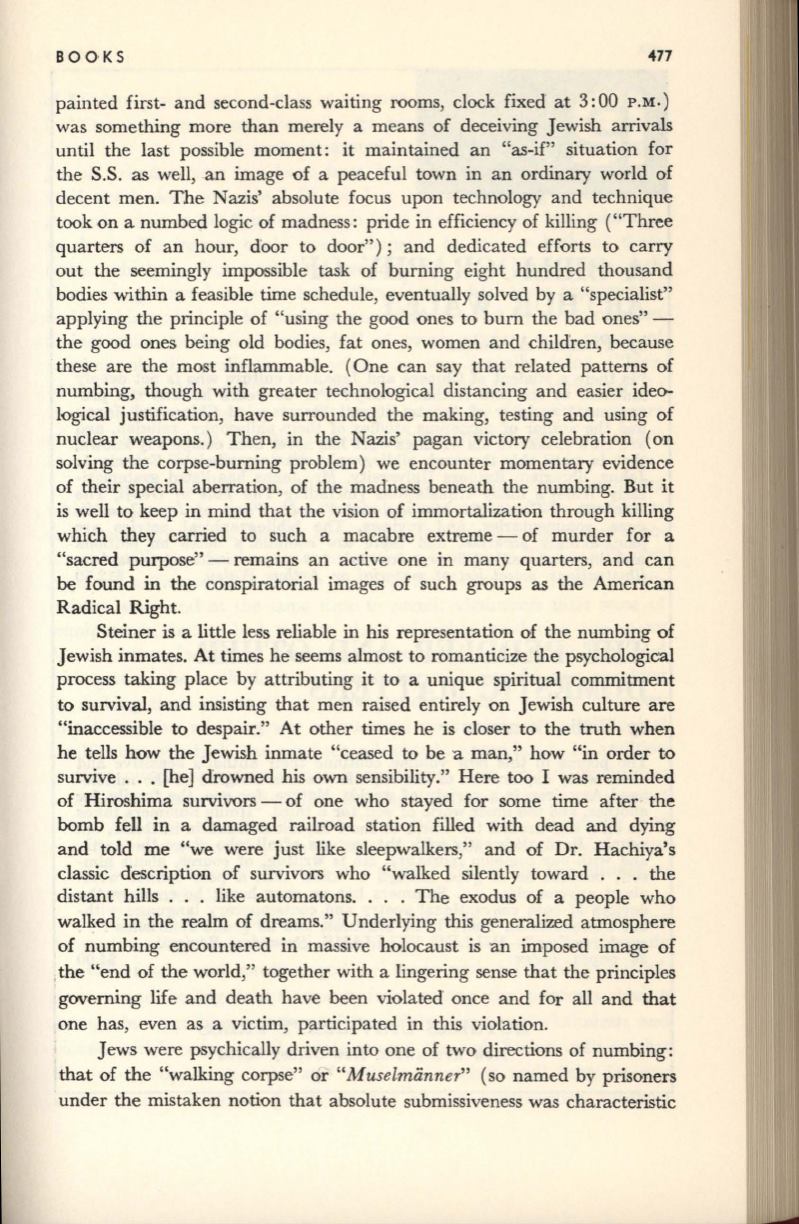
BOOKS
painted first- and second-class waiting rooms, clock fixed at 3: 00
P.M.)
was something more than merely a means of deceiving Jewish arrivals
until the last possible moment: it maintained an "as-if" situation for
the S.S. as well, an image of a peaceful town in an ordinary world of
decent men. The Nazis' absolute focus upon technology and technique
took on a numbed logic of madness: pride in efficiency of killing ("Three
quarters of an hour, door to door"); and dedicated efforts to carry
out the seemingly impossible task of burning eight hundred thousand
bodies within a feasible time schedule, eventually solved by a "specialist"
applying the principle of "using the good ones to burn the bad ones" -
the good ones being old bodies, fat ones, women and children, because
these are the most inflammable. (One can say that related patterns of
numbing, though with greater technological distancing and easier ideo–
logical justification, have surrounded the making, testing and using of
nuclear weapons.) Then, in the Nazis' pagan victory celebration (on
solving the corpse-burning problem) we encounter momentary evidence
of their special aberration, of the madness beneath the numbing. But it
is well to keep in mind that the vision of immortalization through killing
which they carried to such a macabre extreme - of murder for a
"sacred purpose" - remains an active one in many quarters, and can
be
found in the conspiratorial images of such groups as the American
Radical Right.
Steiner is a little less reliable in his representation of the numbing of
Jewish inmates. At times he seems almost to romanticize the psychological
process taking place by attributing it to a unique spiritual commitment
to survival, and insisting that men raised entirely on Jewish culture are
"inaccessible to despair." At other times he is closer to the truth when
he tells how the Jewish inmate "ceased to be 'a man," how "in order to
survive ... [he] drowned his own sensibility." Here too I was reminded
of Hiroshima survivors - of one who stayed for some time after
the
bomb fell in a damaged railroad station filled with dead and dying
and told me "we were just like sleepwalkers," and of Dr. Hachiya's
classic description of survivors who "walked silently toward . . . the
distant hills . . . like automatons. . . . The exodus of a people who
walked in the realm of dreams." Underlying this generalized atmosphere
of numbing encountered in massive holocaust is an imposed image of
,the "end of the world," together with a lingering sense that the principles
governing life and death have been violated once and for all and that
one has, even as a victim, Pilrticipated in this violation.
Jews were psychically driven into one of two directions of numbing:
that of the "walking corpse" or
"Muselmiinner"
(so named by prisoners
under the mistaken notion that absolute submissiveness was characteristic


